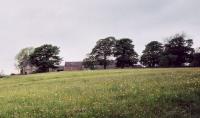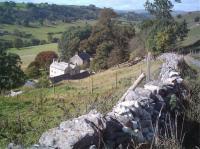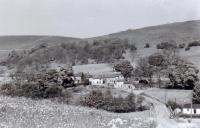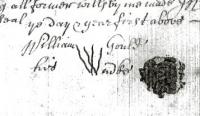
Nat Gould
His life and books
William Gould 1655-1725
| William Gould |
|---|
| Born: 1655 Herbage, Staffordshire |
| Died: 1725 Crowdecote, Derbyshire |
| Father |
| John Gould 1628-1669 |
| Mother |
| Elizabeth (surname unknown) |
| Siblings |
| John Gould |
| Mary Gould |
| Spouse |
| Mary Hollis 1654-1713 |
| Children |
| Elizabeth Gould 1676-1753 |
| William Gould 1677-1772 |
| Lidia Gould |
| Joseph Gould 1685-1760 |
| Sarah Gould 1689-1772 |
| Hannah Gould 1692-1756 |
| Thomas Gould 1695-1763 |
| John Gould 1700-1725 |
William Gould was probably born in 1655 at Herbage in the Staffordshire moorlands, the ancestral home of his family. He was evidently the William Gould who was baptised at Leek in Staffordshire on 15 November 1655, the son of John and Elizabeth Gould of Leekfrith (1).
His father died in 1669, leaving his stock and other possessions to his wife and elder son John Gould, and legacies to his younger son William Gould and daughter Mary Gould. John Gould continued farming at Herbage, which had been the family home for generations, while William Gould moved to The Lowe near Longnor then in the Staffordshire parish of Alstonefield (2).
On 29 March 1684 he took a lease of the large ancient farm Pilsbury Grange in the upper Dove valley from the Earl of Devonshire (3). He and his wife Mary brought with them a daughter Elizabeth, a son also named William, and possibly their daughter Lidia (4). They had three more sons and two more daughters. William Gould established a dynasty at Pilsbury Grange and his descendants were to live there for the next two centuries.
William Gould was a wealthy man, well able to afford the high rent of Pilsbury Grange. He owned considerable other property, including his own farm and lime kiln at Crowdecote and property in Alstonefield and Longnor, as well as holding the leases of Cronkstone Grange, Parkhouse Farm near Earl Sterndale, and the valuable Crowdecote corn mill.
In 1685 Pilsbury would have looked much the same as at the beginning of that century before the start of the Civil Wars (5). However, after William Gould arrived in 1684, considerable changes took place. The older part of the present day Pilsbury Grange was built, apparently without financial assistance from the landlord (6).
As his family grew up, William Gould had to make provision for his four sons, as well as providing marriage portions for his four daughters. He purchased the farm at Bridge End in Crowdecote in 1775. He and his wife settled there, and William Gould also seems to have managed the Parkhouse Farm himself (7). William Gould had divided the Pilsbury Grange farm between his two eldest sons, William and Joseph Gould (8).
Thomas Gould took on the farm at Cronkstone Grange (9) which had been leased by William Gould for his son early in the eighteenth century, towards the end of his life. Thomas Gould had married in 1716 and was twenty eight years old in 1723, when the previous tenant died, and so William Gould probably took on the lease in that year when his son needed a farm for himself (10).
The youngest son John Gould was apprenticed to Samuel Richards of the Ironmongers' Company on 4 July 1715 (11). He lived in London, and presumably he entered some trade or profession, perhaps the silversmith and cutlery trade that had been established by and enriched his maternal grandfather. He died a bachelor on 26 September 1725. Probate of his Will dated 22 September 1725 was granted on 14 October 1725.
William Gould died in 1725 at Crowdecote, and was buried at Hartington on 28 August in that year. His Will is dated 15 August in that year (12). He appointed his sons William and Joseph as executors, and probate was granted on 16 June 1726. The terms of the will are clear and precise. Although William Gould could not write even his own signature, they are those of an accomplished businessman. The will is also clearly the last discourse of a loving father of his family and of a devoutly religious man, being couched in words more than conventionally pious.
Attached to the Will is an Inventory of the property that William Gould possessed when he died, which was taken on 31 August 1725. It is very informative, giving details of the furniture and other goods that were in the various rooms of the Crowdecote farm.
The Will and Inventory together give a picture of the wealth of William Gould as being based on sheep farming and the profitable wool trade. He also was the miller of Crowdecote which had a monopoly of grinding corn in the area, and he owned a lime kiln also at Crowdecote. His income was such as to allow him to have £100 in ready money, and clearly his revenue allowed him to provide the same sum each year as legacies for his daughters and younger sons. At the same time he was a genuinely devout man, rightly proud of his accomplishments but grateful for his good fortune. His Gospel Crofts property in Alstonefield parish was probably the source of the income for the Gould Charity at Warslow, by which is commemorated the family origins in the moorland valley of Elkstone from which William Gould had first migrated to Pilsbury and the Dove valley.
(1) Origins of the Goulds of Pilsbury, near Hartington, Derbyshire by Ann and Michael Hanson (2009). When William Gould was baptised in 1655 his parents were recorded as of Leekfrith. Lying between Leek and Elkstones, the moorland parish of Leekfrith has had boundary changes over the centuries: www.british-history.ac.uk "Leek - Leekfrith" C.R.J. Currie, M.W. Greenslade (editors) and others (1996) pages 191 to 201.
(2) The Lowe was in the township of Fawfieldhead and parish of Alstonefield. Warslow and Elkstones township was in the same parish, Elkstones comprising Upper Elkstone and Lower Elkstone. William Gould was living at The Lowe by 1680 when he was mentioned in a probate grant to Ann Kidd of Wood End in Sheen dated 27 April 1680: Derbyshire Record Office D2209. He was resident there when he took a lease of Pilsbury Grange across the river Dove in Hartington parish in 1684: Devonshire Collections AS/350/1.
(3) Devonshire Collections AS/350/1. For details see Lease of Pilsbury Grange 1684. The lease set the annual rent at £93, a considerable sum for that time. It also stated that he was to be the tenant of only “a moiety” (one half) of the farm. No mention was then made of leasing the other half, but William Gould became the tenant of the whole farm.
(4) The date of the birth of Lidia Gould is unknown, as her baptism is not listed in the extant (damaged) Hartington parish register. She was however included as a legatee in her father's Will.
(5) Between 1642 and 1660 Derbyshire had been severely ravaged by the contending armies, so it is unlikely that much development had taken place at Pilsbury in the seventeenth century before its lease by William Gould in 1684.
(6) No payment for the building of Pilsbury Grange has been found in extant estate records. That however would not have been unusual. Stone, wood and other materials for its construction would have been freely allowed by the estate steward. The building cost would be reflected in the terms of the lease.
(7) They were living there at least as early as 1713 when their daughter Sarah was married. Her mother Mary Gould died in that same year on 30 April 1713 and was buried at Hartington on 2 May 1713. She is described in the parish register as being of Crowdecote, as was Sarah upon her marriage.
(8) The older son William Gould had the “Upper House” and his younger brother Joseph Gould had the “Lower House”. These names were those used by William Gould's great-grandson Thomas Bateman when compiling the family tree in the 1820s. The Upper House stands on slightly higher ground than the present Lower House. Bateman was following what another great-grandson William Gould of Hanson Grange told him. The names refer to the height of the two houses rather than to their positions upstream or downstream in the Dove valley. The Lower House was built in 1743 : Hartington Estate Accounts AS 1383: Devonshire Collections at Chatsworth.
(9) This had been another bercary (or sheep farm) of Merevale Abbey, and had been, together with the bercary at nearby Pilsbury Grange, the most valuable property of the abbey before the monasteries were destroyed by Henry VIII in the sixteenth century. After passing through other hands, it was purchased by the Cavendish family, as was Pilsbury Grange, and so passed into the estate of the Earls and Dukes of Devonshire.
(10) When William Gould arrived at Pilsbury in 1684 Cronkstone Grange was tenanted by a branch of the Edensor family into which his eldest daughter was to marry in 1713. Edward Edensor of Cronkstone was buried at Hartington on 11 March 1723, his wife Barbara Edensor having predeceased him, being buried there on 18 June 1709. In the previous century the tenant had been John Doughty, who died in 1633.
(11) London Apprenticeship Abstracts 1442-1850.
(12) The probate copy of the Will and the Inventory are in the Lichfield Record Office.




